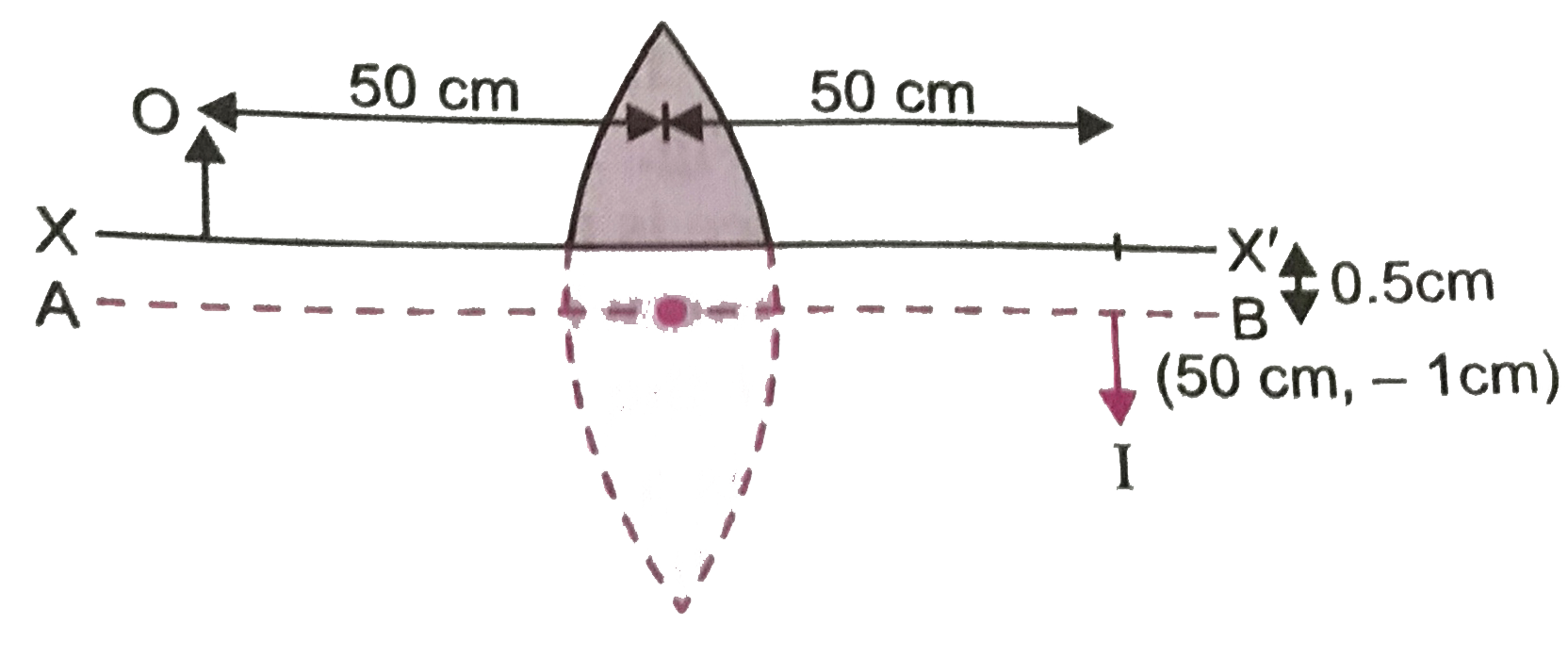A thin convex lens of focal length 25cm is cut into two pieces 0.5cm above the principal axis. The top part is placed at (0.0) and an object placed at (−50cm,0). Find the coordinates of the image.
In Fig., AB is the principal axis of original thin convex lens of f=25cm. If has been cut into two pieces 0.5cm above the principal axis. The top part is placed at (0,0) and object O is at (−50cm,0).
If there were no cut, the object would have been at a height 0.5cm from principal axis AB.
As 1v−1u=1f
1v=1f+1u=125−150=150∴v=50cm
Magnification, μ=vu=50−50=−1
Thus, the iamge would have been formed at 50cm from the pole on right side of lens and 0.5cm below the principal axis. Hence, w.r.t. the X - axis passing through the edge of the cut lens, the co-ordinates of the image are (50cm,−1cm).

Topper's Solved these Questions
- RAY OPTICSBOOK - PRADEEPCHAPTER - RAY OPTICSEXERCISE - Long Answer (b)
15 Videos
- RAY OPTICSBOOK - PRADEEPCHAPTER - RAY OPTICSEXERCISE - Long Answer (c)
8 Videos
- RAY OPTICSBOOK - PRADEEPCHAPTER - RAY OPTICSEXERCISE - Short Answer(d)
17 Videos
- PROPERTIES OF BULK MATTERBOOK - PRADEEPCHAPTER - PROPERTIES OF BULK MATTEREXERCISE - Multiple choice questions
7 Videos
- SYSTEMS OF PARTICLES AND ROTATIONAL MOTIONBOOK - PRADEEPCHAPTER - SYSTEMS OF PARTICLES AND ROTATIONAL MOTIONEXERCISE - Assertion- Reason Type questions
20 Videos
Similar Questions
A convex lens of focal length 10 cm is placed coaxially 5 cm away from a concave lens of focal length 10 cm. If an object is placed 30 cm in front of the convex lens, find the position of the final image formed by the combined system.
View SolutionA convex lens of focal length 10 cm is placed coaxially 5 cm away from a concave lens of focal length 10 cm. If an object is placed 30 cm in front of the convex lens, find the position of the final image formed by the combined system.
View Solution
Knowledge Check
A convex lens of focal length 15 cm is placed on a plane mirror. An object is placed at 30 cm from the lens. The image is
Areal, at 30 cm in front of the mirrorBreal, at 30 cm behind the mirrorCreal, at 10 cm in front of the mirrorDvirtual, at 10 cm behind the mirrorA convex lens of focal length 15 cm is placed on a plane mirror. An object is placed 20 cm from the lens. The image is formed
A12 cm in front of the mirrorB60 cm behind the mirrorC60 cm in front of the mirrorD30 cm in front of the mirrorAn optical system consists of a thin convex lens of focal length 30cm and a plane mirror placed 15cm behind the lens. An object is placed 15cm in front of the lens. The distance of the final image from the object is
A60cmB30cmC75cmD45cm
An object 3.0 cm high is placed perpendicular to the principal axis of a concave lens of focal length 7⋅5 cm. The image is formed at a distance of 5.0 cm from the lens. Calculate (i) distance at which object is placed, and (ii) size and nature of image formed.
View SolutionA convex lens of focal length 30cm and a concave lens of focal length 60cm are placed in combination. If an object is placed 40cm away from the combination, find the position of the image.
View SolutionAn object is placed at a distance of 10cmm to the left on the axis of convex lens A of focal length 20cm. A second convex lens of focal length 10cm is placed coaxially to the right of the lens A at a distance of 5cm from A. Find the position of the final image and its magnification. Trace teh path of the rays.
View SolutionA converging lens of focal length 15 cm and a converging mirror of focal length 10 cm are placed 50 cm apart with common principal axis. A point source is placed in between the lens and the mirror at a distance of 40 cm from the lens. Find the locations of the two images formed.
View SolutionA convex lens of focal length 10cm is placed co-axially 5cm away from a concave lens of focal length 10cm. If an object is placed 30cm in front of the convex lens, find the position of final image formed by the combined system.
View Solution
